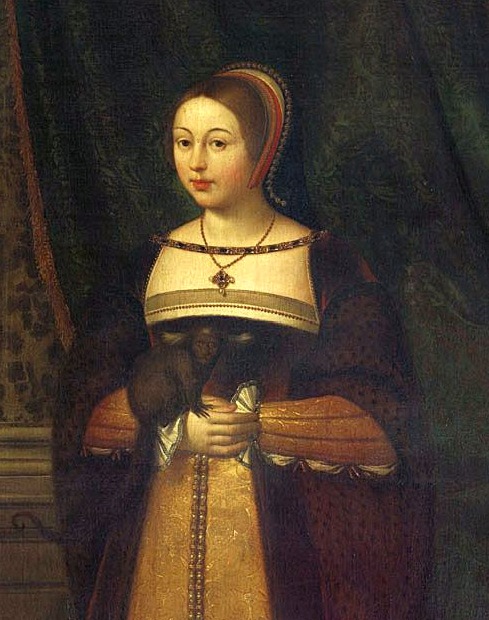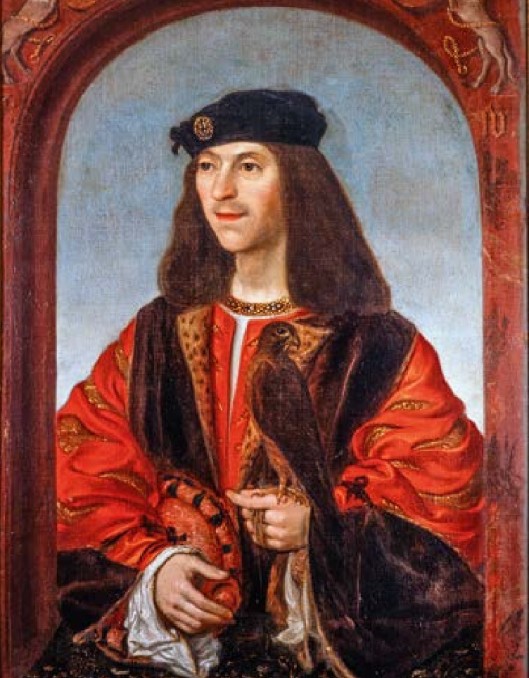Tags
6th Earl of Angus, Archibald Douglas, Battle of Flodden, Elizabeth of York, Henry Stuart, Henry VII of England, Henry VIII of England, Holy Roman Emperor Maximilian I, House of Stewart, House of Tudor, King James IV of Scotland, Lord Darnley, Louis XI of France, Margaret Tudor, Pope Julius II, Queen Mary I of Scotland
Margaret Tudor (November 28, 1489 – October 18, 1541) was Queen of Scotland from 1503 until 1513 by marriage to King James IV. She was the eldest daughter and second child of King Henry VII of England and Elizabeth of York, and the sister of King Henry VIII of England.
Margaret married James IV at the age of 13, in accordance with the Treaty of Perpetual Peace between England and Scotland. Together, they had six children, though only one of them reached adulthood. Margaret’s marriage to James IV linked the royal houses of England and Scotland, which a century later resulted in the Union of the Crowns.
Early life
Margaret was born on November 28, 1489 in the Palace of Westminster in London to King Henry VII and his wife, Elizabeth of York. She was their second child and firstborn daughter. Her siblings included Arthur, Prince of Wales, the future King Henry VIII, and Mary, who would briefly become Queen of France.

Margaret Tudor
Margaret was baptised in St. Margaret’s, Westminster on St Andrew’s Day. She was named after Margaret Beaufort, Countess of Richmond and Derby, her paternal grandmother. Her nurse was Alice Davy.
On September 30, 1497, James IV’s commissioner, the Spaniard Pedro de Ayala concluded a lengthy truce with England, and now the marriage was again a serious possibility. James IV was in his late twenties and still unmarried. The Italian historian Polydore Vergil said that some of the English royal council objected to the match, saying that it would bring the Stewarts directly into the line of English succession, to which the wily and astute Henry replied:
What then? Should anything of the kind happen (and God avert the omen), I foresee that our realm would suffer no harm, since England would not be absorbed by Scotland, but rather Scotland by England, being the noblest head of the entire island, since there is always less glory and honour in being joined to that which is far the greater, just as Normandy once came under the rule and power of our ancestors the English.
On January 24, 1502, Scotland and England concluded the Treaty of Perpetual Peace, the first peace agreement between the two realms in over 170 years. The marriage treaty was concluded the same day and was viewed as a guarantee of the new peace. Margaret remained in England, but was now known as the “Queen of Scots”.
Marriage and progress
The marriage was completed by proxy on January 25, 1503 at Richmond Palace. The Earl of Bothwell was proxy for the Scottish king and wore a gown of cloth-of-gold at the ceremony in the Queen’s great chamber. He was accompanied by Robert Blackadder, archbishop of Glasgow, and Andrew Forman, postulate of Moray.
The herald, John Young, reported that “right notable jousts” followed the ceremony. Prizes were awarded the next morning, and the tournament continued another day.
The new queen was provided with a large wardrobe of clothes, and her crimson state bed curtains made of Italian sarcenet were embroidered with red Lancastrian roses. Clothes were also made for her companion, Lady Catherine Gordon, the widow of Perkin Warbeck. The clothes were embroidered by John Flee.

James IV, King of Scotland
In May 1503, James IV confirmed her possession of lands and houses in Scotland, including Methven Castle, Stirling Castle, Doune Castle, Linlithgow Palace and Newark Castle in Ettrick Forest, with the incomes from the corresponding earldom and lordship lands.
Later in 1503, months after the death of her mother, Queen Elizabeth (of York) Margaret came to Scotland; her progress was a grand journey northward. She left Richmond Palace on June 27, with Henry VII, and they travelled first to Collyweston in Northamptonshire.
At York a plaque commemorates the exact spot where the Queen of Scots entered its gates. After crossing the border at Berwick upon Tweed on August 1, 1503, Margaret was met by the Scottish court at Lamberton. At Dalkeith Palace, James came to kiss her goodnight. He came again to console her on August 4 after a stable fire had killed some of her favourite horses. Her riding gear, including a new sumpter cloth or pallion of cloth-of-gold worth £127 was destroyed in the fire.
At a meadow a mile from Edinburgh, there was a pavilion where Sir Patrick Hamilton and Patrick Sinclair played and fought in the guise of knights defending their ladies.
On August 8, 1503, the marriage was celebrated in person in Holyrood Abbey. The rites were performed by the archbishop of Glasgow and Thomas Savage, archbishop of York. Two days later, on St Lawrence’s day, Margaret went to mass at St Giles’, the town’s Kirk, as her first public appointment. The details of the proxy marriage, progress, arrival, and reception in Edinburgh were recorded by the Somerset Herald, John Young.
The marriage led to the Union of the Crowns in 1603, when Elizabeth I of England died without heirs and James IV’s great-grandson James VI succeeded to the English throne.
The long period of domestic peace after 1497 allowed James IV to focus more on foreign policy, which included the sending of several of his warships to aid his uncle, King Hans of Denmark, in his conflict with Sweden; amicable relations with the Pope, Holy Roman Emperor Maximilian I and Louis XII of France; and James’s aspiration to lead a European naval crusade against the Turks of the Ottoman Empire. James was granted the title of Protector and Defender of the Christian Faith in 1507 by Pope Julius II.
Following the death of James IV at the Battle of Flodden in 1513, Margaret, as queen dowager, was appointed as regent for their son, King James V.
A pro-French party took shape among the nobility, urging that she should be replaced by John, Duke of Albany, the closest male relative to the infant king. In seeking allies, Margaret turned to the Douglases, and in 1514 she married Archibald Douglas, 6th Earl of Angus, which alienated the nobility and saw her replaced as regent by Albany.
In 1524, Margaret, with the help of the Hamiltons, removed Albany from power in a coup d’état while he was in France, and was recognised by Parliament as regent, then later as chief counsellor to King James V.
Following her divorce from Angus in 1527, Margaret married her third husband, Henry Stewart, 1st Lord Methven. Through her first and second marriages, Margaret was the grandmother of both Queen Mary I of Scotland, and Mary’s second husband, Henry Stuart, Lord Darnley.
